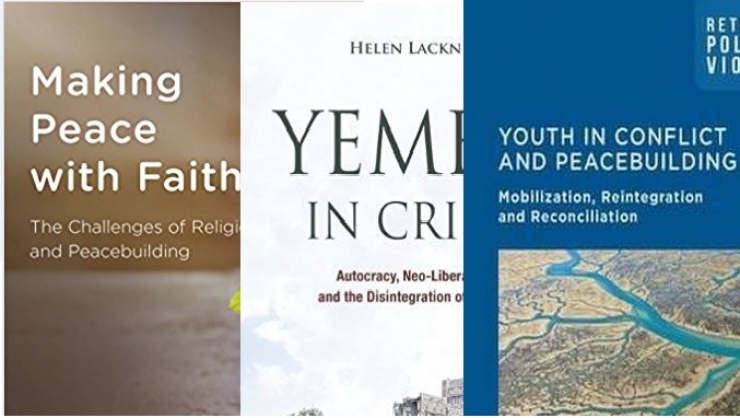New books have arrived at the GDRSC library on April 2018. The books revolve mainly on the different approaches of peacebuilding planning, post- conflict reconstruction and the complications that lie behind the crisis Yemen is currently undergoing.
The following are reviews on some of the new arrivals:
YEMEN IN CRISIS: Autocracy, Neo- Liberalism and the Disintegration of a State
HELEN LACKNER
The book begins with a very concise and commendable summary of the difficult and ultimately failed political transition process that began in spring 2011 and ended with the launch of the Saudi-led bombing campaign in 2015. The nine following chapters explore the historical roots of the current crisis in Yemen by addressing very different but closely related aspects of its recent history: the influence of foreign states on Yemen’s development and politics, the history of the two Yemeni republics (YAR and PDRY) from their establishment in the 1960s to their unification in 1990, the role of political Islam, the emergence of the Houthi movement in the country’s north and the secessionist movement in its south, the changing role of tribalism in Yemeni society and politics, the deficient economy, and the country’s rural-urban nexus. In doing so, Lackner presents the many complex historical, political, economic and social problems whose synergy led to the current situation in Yemen.
Making Peace with Faith: The Challenges of Religion and Peacebuilding
Michelle Garred
In this book, practitioners from different faiths relate and explore the many challenges they face in their peacebuilding work, which their secular partners may be unaware of. The contributors are all practitioners whose faith or religious experience motivates their work for peace and justice in such a way that it influences their actions. Their roles are diverse, as some work for faith-based institutions, while others engage in secular contexts. The multiple perspectives featured represent multiple faiths (Muslim, Christian, Hindu, Buddhist, Jewish), diverse scopes of practice, different geographic regions.
Each chapter follows a similar template to address specific challenges, such as dealing with extremist views, addressing negative stereotypes about one’s faith, endorsing violence, developing relations with other faith-based or secular groups, confronting gender-based violence, and working with people who hold different beliefs. The text provides a comprehensive view of the practice of peacebuilding in its many challenging aspects, for both professionals and those studying religion and peacebuilding alike.
Youth in Conflict and Peacebuilding: Mobilization, Reintegration and Reconciliation
Alpaslan Özerdem, S. Podder
Youth in Conflict and Peacebuilding gives weight to the role of youth in peacebuilding, with specific reference to the processes of mobilisation, reintegration and reconciliation. The main objective of Özerdem and Podder in this study is to provide a new conceptualisation of youth as a harbinger of peace, whether at an international or local level. The failure to recognise youths as political actors can result in their contribution to peacebuilding being ignored, wasted and, at best, under-utilised. In recognising their agency as legitimate political actors, Özerdem and Podder address the need for a comprehensive understanding of their valuable contribution to peacebuilding.
